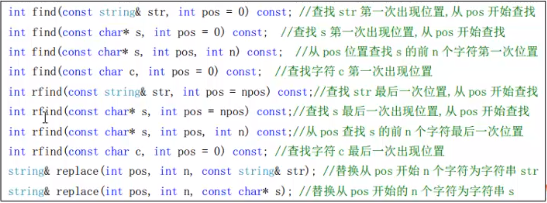string容器
一、string特性
string是STL的字符串类型,通常用来表示字符串。而在使用string之前,字符串通常是用char*表示的,string与char*都可以用来表示字符串。
说到string的特性,就不得不和char*类型的字符串对比:
1、char*是一个指针,string是一个类
string封装了char*,管理这个字符串,是一个char*型的容器。
2、string封装了很多实用的成员方法
查找find,拷贝copy,删除delete,替换replace,插入insert
3、不用考虑内存释放和越界
string管理char*所分配的内存,每一次string的复制,取值都由string类负责维护,不用担心复制越界和取值越界等。
4、string和char*可以相互转换,string转char*通过string提供的c_str()方法。
//string转char* string str=“itcast”; const char* cstr=str.c_str(); //char*转string char* s=“itcast”; string sstr(s);
二、string初始化、拼接、赋值、查找、替换、比较、子串、插入和删除
1、string构造函数
用string初始化字符串分两类:用“=”号就是拷贝初始化,否则就是直接初始化。


默认构造函数: string(); //构造一个空的字符串string s1。 拷贝构造函数: string(const string &str); //构造一个与str一样的string。如string s1(s2)。 带参数的构造函数 string(const char *s); //用字符串s初始化 string(int n,char c); //用n个字符c初始化
例子:
string s1;//初始化字符串,空字符串 string s2 = s1; //拷贝初始化,深拷贝字符串 string s3 = "I am Yasuo"; //直接初始化,s3存了字符串 string s4(10, 'a'); //s4存的字符串是aaaaaaaaaa string s5(s4); //拷贝初始化,深拷贝字符串 string s6("I am Ali"); //直接初始化 string s7 = string(6, 'c'); //拷贝初始化,cccccc
2、string存取字符操作
char& operator[](int n);//通过[]方式取字符 char& at(int n);//通过at方法获取字符 //例子: string s="itcast"; char c=s[1]; c=s.at(1);
3、string基本赋值操作

4、string拼接

5、string查找和替换

6、string比较

7、string子串

8、string插入和删除

三、案例
#define _CRT_SECURE_NO_WARNINGS #include <iostream> #include <string> using namespace std; //string初始化 void test01() { string s1;//调用无参构造,初始化字符串,空字符串 string s2(10, 'a'); string s3("abcdefg"); string s4(s3); cout << s1 << endl;//空字符串 cout << s2 << endl;//aaaaaaaaaa cout << s3 << endl;//abcdefg cout << s4 << endl;//abcdefg } //string赋值操作 void test02() { string s1;//调用无参构造,初始化字符串,空字符串 string s2("appp"); s1 = "abcdefg"; cout << s1 << endl; s1 = s2; cout << s1 << endl; s1 = "a"; cout << s1 << endl; //成员方法 s1.assign("jkl"); cout << s1 << endl; } //取值操作 void test03() { string s1 = "abcdefg"; //重载[]操作符 for (int i = 0;i < s1.size();i++) { cout << s1[i] << " "; } cout << endl; //at成员函数 for (int i = 0;i < s1.size();i++) { cout << s1.at(i) << " "; } cout << endl; //这两种方法的区别: //[]方式 如果访问越界,直接挂了 //at方式 访问越界 抛异常out_of_range try { cout << s1.at(100) << endl; } catch (...) { cout << "越界!" << endl; } } //string拼接操作 void test04() { string s = "abcd"; string s2 = "1111"; s += "abcd"; s += s2; cout << s << endl;//abcdabcd1111 string s3 = "2222"; s2.append(s3); cout << s2 << endl;//11112222 string s4 = s2 + s3; cout << s4 << endl;//111122222222 } //string查找操作 void test05() { string s = "abcdefghjfgkl"; //查找第一次出现的位置 int pos = s.find("fg"); cout << "pos:" << pos << endl;//pos:5 //查找最后一次出现的位置 pos = s.rfind("fg"); cout << "pos:" << pos << endl;//pos:9 } //string替换操作 void test06() { string s = "abcdefg"; s.replace(0, 2, "111"); cout << s << endl;//111cdefg } //string比较操作: //compare函数在>时返回1,<时返回-1,==时返回0. //比较区分大小写,比较时参考字典顺序,排越前面的越小。 //大写的A比小写的a小。 void test07() { string s1 = "abcd"; string s2 = "abed"; if (s1.compare(s2) == 0) { cout << "s1与s2相等" << endl; } else if(s1.compare(s2) > 0) { cout << "s1大于s2" << endl; } else { cout << "s1小于s2" << endl;//s1小于s2 } } //string子串操作 void test08() { string s = "abcdefg"; string mysubstr = s.substr(1, 3); cout << mysubstr << endl;//bcd } //string插入和删除操作 void test09() { string s = "abcdefg"; s.insert(3, "111"); cout << s << endl;//abc111defg s.erase(0, 2); cout << s << endl;//c111defg } int main(void) { //test01(); //test02(); //test03(); //test04(); //test05(); //test06(); //test07(); //test08(); test09(); return 0; }
部分参考了:https://blog.csdn.net/zyq522376829/article/details/46792893






